|
|


RECOMMENDED BY JIM PORTER
FARM 13 / STICK MARSH FISHING REPORT
NOVEMBER 2001
November 29, 2001
Gonna tell you a couple of fishing tales this time - one about the Stick Marsh and the other about our best kept secret, Kenansville Lake.
Before you skip over the part about Kenansville Lake, let me tell you a few facts:
- It is a sister to the Stick Marsh and was built for the same reason.
- It is two miles from the Stick Marsh, as the old crow flies.
- Although I have never caught a bass over 8 lbs in K'ville lake, I have caught over 100 a day numerous times
- It has more 1+ pound bluegill per area of water than any place I have ever seen. I have had 10 in a net that weighed 22 lbs.
- It has more crappie per area of water than any place I have ever seen, and that includes the Stick Marsh, Lake Okeechobee, and Weiss Lake, AL.
We'll get back to K'ville.
I get asked a lot, "When is he best time to fish the Marsh?" Pure fact: the Marsh is fine year-round. In all honesty, I really think the fishing is at its absolute best when the weather is the hottest. Mid-Summer, 95 degrees, major sweat time. But, fishing is superb. It is just too hot to punish yourself, except later afternoon. That's the time of year we get a lot of 30-50 fish days on artificials with just 2-3 hours of fishing.
If you asked when is the BEST TIME to fish the Marsh, I would tell you Nov through April, because it is so comfortable in Fla for that period. The fishing is great and the weather 65-75 degrees. It's a hard place to have to live and fish, but someone has to do it.
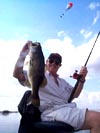 Right now, shiners are really the best bait of choice. Knowing where to fish them and how makes a big difference, however. If you spend money to travel here, motels, food, etc., to fish for 4-7 days, it is really cost effective to hire some guide for at least ˝ day. If you are going to spend $100 a day for shiners, you absolutely MUST know how to use them so they are not a waste. They are expensive critters!! The guide doesn't need to be me, by any means. I fish too much now. And, there are a lot of good guides around. You can feel free to contact me and I will put you in contact with a reputable, dependable and knowledgeable guide. Someone who really likes to fish.
Right now, shiners are really the best bait of choice. Knowing where to fish them and how makes a big difference, however. If you spend money to travel here, motels, food, etc., to fish for 4-7 days, it is really cost effective to hire some guide for at least ˝ day. If you are going to spend $100 a day for shiners, you absolutely MUST know how to use them so they are not a waste. They are expensive critters!! The guide doesn't need to be me, by any means. I fish too much now. And, there are a lot of good guides around. You can feel free to contact me and I will put you in contact with a reputable, dependable and knowledgeable guide. Someone who really likes to fish.
Always a hot spot for shiners are areas around the gates when they are passing water. It is like fishing in a barrel sometimes, and a lot like fishing in a crowded mall, most times. I won't even do it if there are other boats in there. There are places out in the Farm and Marsh that are just as good for the shiners, but you need to know where they are. Any grass or wood will have some bass. But, there are some locations that have proven, over the years, to be something special. Maybe they are on a movement route, or whatever. Who knows? They just produce a LOT of fish. Catching lots of fish normally means you will get some big ones mixed in. If the average shiner fish is not 3-4 lbs., there are better places for you to fish. Just have to know the water and where they have habitually been caught.
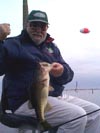 Shiner fishing also has another little quirk you need to know about - and that is the 'chumming' syndrome. If you are in a good location for fishing shiners, you will often find that you may start out slow, with action only every 15-30 minutes. But, once you catch a couple of fish, the tempo will increase. It is like the bass put out the word that they have found a feeding spot full of shiners. It often gets better and better as you sit there. What I am trying to say is, don't be too quick to move. Moving around too fast and changing holes every few minutes never lets a location develop. The guys that tell me they dunked shiners in 20 spots with no luck have actually told me exactly why they caught no fish.
Shiner fishing also has another little quirk you need to know about - and that is the 'chumming' syndrome. If you are in a good location for fishing shiners, you will often find that you may start out slow, with action only every 15-30 minutes. But, once you catch a couple of fish, the tempo will increase. It is like the bass put out the word that they have found a feeding spot full of shiners. It often gets better and better as you sit there. What I am trying to say is, don't be too quick to move. Moving around too fast and changing holes every few minutes never lets a location develop. The guys that tell me they dunked shiners in 20 spots with no luck have actually told me exactly why they caught no fish.
Bobber fishing shiners is fine and should be done at 3-4 feet. Does not need to be deeper. Bass will come to the shiner. Balloons instead of bobbers are a way to make someone think the guide a real semi-pro. Balloons came into use where the cover was thick and there were a lot of reeds (Lake Okeechobee was a primary place). The ONLY reason to use a balloon is because it will deform and the shiner can pull it through the grass and reeds as he swims. A hard bobber would hang up. There is no place on the Stick Marsh were a balloon is of any additional advantage. Besides, they are a pain to tie on the line and they leak.
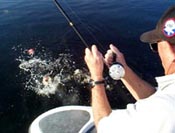 Learn to free-line shiners. All that means it put a hook on the line, put a shiner on the hook and toss that puppy in. Give him free line and let him go. You'll feel him a little, as he swims around. You'll feel him a lot when he sees something with a big mouth giving him the eye. Keep the reel in free-spool or on a clicker. Strikes on free-lined shiners usually come 2 ways - the bass runs the shiner to the surface and blows him up (you KNOW that is a strike!!!), or the line starts to swim off slowly and steadily. Shiners usually pull the line erratically. Bass take the shiner and just swim off. Simply engage the spool, point the rod tip at the bass, and set the hook only when the line comes tight. If he comes back to the boat at you, reel in slack until the bass is passing the boat or going under it, and set when it comes tight. They won't come back at you much.
Learn to free-line shiners. All that means it put a hook on the line, put a shiner on the hook and toss that puppy in. Give him free line and let him go. You'll feel him a little, as he swims around. You'll feel him a lot when he sees something with a big mouth giving him the eye. Keep the reel in free-spool or on a clicker. Strikes on free-lined shiners usually come 2 ways - the bass runs the shiner to the surface and blows him up (you KNOW that is a strike!!!), or the line starts to swim off slowly and steadily. Shiners usually pull the line erratically. Bass take the shiner and just swim off. Simply engage the spool, point the rod tip at the bass, and set the hook only when the line comes tight. If he comes back to the boat at you, reel in slack until the bass is passing the boat or going under it, and set when it comes tight. They won't come back at you much.
Right now, think west, north and northwest on both the Farm and the Marsh. Those are the instinctive spawning areas for the bass. Lots of small fish in the shallows now, which are simply a prelude to the bigger ones moving in by mid-Dec, or before.
Artificials on the top of the list now are the Manns Minus 1, a small Texas rig worm, a slowly worked rapala-type lure, a fluke, and most any slow lure at 3 feet or less.
Kenansville - If you look at a real map of the Stick Marsh, you will find Blue Cypress Lake right on the SW corner of the Stick Marsh. You will also find another big, rectangular lake on the NW corner. That is K'ville Lake. Unfortunately, we can't easily get from one to the other. None are connected to any of the others. So, we have to drive 55 miles around to the K'ville launch. K'ville is a shallow flooded farm. Still has a lot of fence posts and barbed wire in some places. Depth in the fields is anywhere from 3-5 feet. Lots of drainage ditches criss-crossing the place. Far west side is all reeds, grass, and cypress trees. A canal bisects the place, running E/Wing. The canal has submerged leaves, but they are not far under (translated as you cannot get across them except a certain places) and have grass and reeds all along them. The whole lake is lousy with crappie and bluegill. It has a tremendous bass population, too. But, most folks have trouble figuring it out. The shallow grass areas turn some fish, but that is not the magic pattern. Try the fence lines and the ditches along them sometimes (darn, there goes another secret).
November 24, 2001
This report is going to roll up the past 30 days and then do a forecast for the next 90.
 About a month ago, we started seeing a LOT of small bass in the shallows, especially in the prime spawning areas all along the western levee shoreline, the southwest portion of the Farm and the northwest portion of the Marsh. They acted nuts, to say the least, and attacked just about anything that came by. Often, the lure was bigger than the fish. This told us something, too. From many years of seeing this phenomenon happen, we recognize it is a prelude to the spawn and it helps us SET THE CLOCK. About a month ago, we started seeing a LOT of small bass in the shallows, especially in the prime spawning areas all along the western levee shoreline, the southwest portion of the Farm and the northwest portion of the Marsh. They acted nuts, to say the least, and attacked just about anything that came by. Often, the lure was bigger than the fish. This told us something, too. From many years of seeing this phenomenon happen, we recognize it is a prelude to the spawn and it helps us SET THE CLOCK.
Past experience shows these exceptionally small bass are trying to spawn, but are probably not at a reproductive age yet. However, Nature says to go do it anyway. One thing we know is that the small fish of a species always seem to go to the spawning areas first. Whether it is bass, crappie or bluegills, the small ones always show up first. With Stick Marsh bass, this influx of small bass has historically been 45 days (+/-) before we started to see the 2-4 LB males making beds. So, I expect to see the larger bass heading into the spawning zones around the first of Dec. This tells us we may see some large females around the beds 1-2 weeks from that. In a nutshell, I expect to see decent, catchable bass really pick up in the spawning zones between 1-10 Dec and some genuine "Oh, Son' giants in there by mid-month. And, it should continue until about mid-Jan.
Bass spawning actually goes on all the time, but the primary period is usually over a 60-90 day range. If you drew a graph, it would be a bell curve and this year's peak on that curve would be around Christmas to the first of the year.
 Last week, we did in fact see some larger bass showing up in the shallow zones we were fishing. Whereas before, we had to wade through 10 small fish to get a 2-4 pounder, now it is only 5-6 small ones first. I fully expect this to get better next week. But, it will peak on 5 pounds and under fish, in that males rarely get bigger than 5 (rarely bigger than 3 in the northern states). In that it is the male that builds and guards the nest, as well as who stays and protects the area and the eggs later, he is the one that is aggressive and gets caught. Females on spawn DO NOT actively feed much. About the only way to catch them is to be able to see them and then goad them into striking by repeated casts right to them.
Last week, we did in fact see some larger bass showing up in the shallow zones we were fishing. Whereas before, we had to wade through 10 small fish to get a 2-4 pounder, now it is only 5-6 small ones first. I fully expect this to get better next week. But, it will peak on 5 pounds and under fish, in that males rarely get bigger than 5 (rarely bigger than 3 in the northern states). In that it is the male that builds and guards the nest, as well as who stays and protects the area and the eggs later, he is the one that is aggressive and gets caught. Females on spawn DO NOT actively feed much. About the only way to catch them is to be able to see them and then goad them into striking by repeated casts right to them.
 There is one way to get the big females, but it is a 'find them first' technique. As the males build nests, the female gather outside the nesting zones. How far is a guess. But, those I have watched are usually within 100 feet or so. They seem to lay close enough for the males to be able to make short excursions from the nest to find them. In looking at the areas we typically find spawning bass well in the Stick Marsh (and Farm 13, as well), we have usually found the females in open water where a grass bed or such separates them from the spawning zone. In some cases, that was right in a canal. If you look at farm 13, west side/north to south, you will see a small canal (interactive map coordinates B2 to B7) that runs along that western-most levee. Yes, the big egg-carrying females have most often been right in that canal. That canal is MUCH smaller than the others are than run north/south in the Farm are. It is little more than a ditch from the shack on the west shore back to the north (coordinates B4 to B7; also see picture with map pop-up). It is a bit larger in its southern half (B4 to B2; again, see the related picture), but still small. It also has an oddity about its shape in that southern half.
There is one way to get the big females, but it is a 'find them first' technique. As the males build nests, the female gather outside the nesting zones. How far is a guess. But, those I have watched are usually within 100 feet or so. They seem to lay close enough for the males to be able to make short excursions from the nest to find them. In looking at the areas we typically find spawning bass well in the Stick Marsh (and Farm 13, as well), we have usually found the females in open water where a grass bed or such separates them from the spawning zone. In some cases, that was right in a canal. If you look at farm 13, west side/north to south, you will see a small canal (interactive map coordinates B2 to B7) that runs along that western-most levee. Yes, the big egg-carrying females have most often been right in that canal. That canal is MUCH smaller than the others are than run north/south in the Farm are. It is little more than a ditch from the shack on the west shore back to the north (coordinates B4 to B7; also see picture with map pop-up). It is a bit larger in its southern half (B4 to B2; again, see the related picture), but still small. It also has an oddity about its shape in that southern half.
Most canals are dug with a taper down both sides and the deepest location in its center. Not so the lower half of the Farm's western canal (B4 to B2). In this section, it was dug in a wedge shape, with the deepest location right on the west side. And, there is NO levee on that west side of the canal. All the dirt from digging that section of the canal was piled on the east side and that is a wide low levee. So, it gives the females an open water drop-off to use for reference and cruise along. Absolutely ideal in distance and location from the western shore spawning zones. If the grass lets you, think 'Rat-L-Trap parallel to the canal drop' really hard. Until they are herded to the bed area by a male, a female will still feed (or is aggressive in possibly protecting the 'spawning-area-to-be' - who knows).
The north half of this canal (B4 to B7) is, as stated earlier, basically a ditch. It is not much more that a boat width wide and has some old stumps underwater right in the ditch. The spawning flats are 4-5 feet deep and lots of wood. The grass has thinned a lot recently. Fishing this ditch is a front-of-the-boat-fishing trip. The person in the back just can't do it and you can basically only bring one lure along its narrow trace anyway. But, like its southern counterpart half, this portion of the canal has NO levee on the western side. And the ditch is only a couple of feet deeper than the spawning flats. So, you can expect the females to use the ditch, the edge of the levee to the east along the ditch, and the edge of the spawning flat (i.e., don't confine your search for the big females to just that small ditch; they are not bounded as much as they are in the southern portion).
Lets turn to the Stick Marsh. Spawning areas are all along the western shoreline (A8 - A13) and the north treeline (A13 - G13). Some will also spawn along the north side of the north canal that borders the Marsh (not the exit flow canal; I am speaking of the canal that runs from the ramp to the western side of the Marsh). In that canal, the females simply stage in the open water of the canal, which is full of submerged stumps and brush even in the middle. Along that tree line, between the canal and the Marsh waters, the females may be anywhere in the stumps and grass, but will not be far from that tree line and its levee.
The western shoreline of the Marsh does not have a rim canal. It was never farmed, so there was no specific drainage plan. BUT, (BIG SECRET) there is a ditch that runs parallel to the western shore from A8 to about A11. It is about 100-150 feet off the shoreline. Using a depthfinder and looking slowly, it is found to be about 6-8 feet wide and 1-2 feet deep from A11 to A9. Here, its small levee (maybe a foot high) is on the east side of the ditch proper. From A9 to A8, it enters a wider, deeper 'hole' for a short distance (maybe 30 feet). It has a small section that gets 9-10 feet deep, then comes back up. I suspect this was a sump hole to catch drainage. The sump hole has a higher, well-defined section of submerged levee on its east side (deeper hole = more dirt removed = more levee). Along the east side of that sump hole levee used to be a prime shiner hole in the early days. From the defined sump hole to its intersection with the main east/west canal between the Farm and the Marsh, the ditch is ill defined and basically just a depression that channeled the water out. I can't say that the females use this ditch for anything. BUT, at pre-spawn, they are usually staged between it and the shoreline.
In any of these western-spawning areas, it will be exceptionally rare to see a fish on a bed. The watercolor and the background vegetation just won't allow it. If you get the sun just right, you can see one occasionally - but again, rarely. So, without sight, that means fish a worm or tube very, very slowly, allowing it to lie still for periods of time. If there are reeds, fish in and around them well. Cattails grow in muck; reeds like hard sand bottoms. Bass spawn around reeds a lot.
So, those little goodies of detail will give you something to think about and possibly try out. They have worked well in the past.
As to predictions, it looks like an excellent spawn coming up. The water is clean and high and the bass are exceptionally active. I have found crappie hitting the edges of grassline well for the past 45 days, so their spawn in Feb may be a little early. It usually starts around the 15-20th of the month. If the weather continues with its mild trend, we may see that moved up more towards the earlier days of Feb.
Keep in mind that, even when the peak of the spawn is going on, there are still lots of bass that are not spawning and are in the usual haunts. And, you can expect them to be active.
PLEASE, handle all bass even more carefully during the spawn period. Don't injure or stress them. Give them a chance to do their thing. We all benefit from that.
November 16, 2001
The roadwork is done and it was opened this PM, as scheduled. So, the south side road is the one to use. It looks as though it was disked up and wetted with TerraBond again. Well, it will keep the dust down and maybe it will work a bit better at holding the road together this time. Time will tell.
The winds have been enormously strong and steady from the north and a few locations are a bit dirty due to turbulence. However, most of the water is protected by grass and there is little wave action. So, most is clean and clear. Levels are around 3 inches high.
There is no flow to the NW exit gate and out into the St. Johns marsh yet. SE Farm gate is running at a medium clip and has plenty of fish. But, the best part is the strong winds are funneling water so well that the fish are ganging up at numerous locations other than the gate.
 I had a party cancel out today due to the winds, even though I tried to talk them out of it. So, I went alone around 11AM and fished until 5. It was one of the best days I have had in a long time, with one really big fish and another I could not hold (though it might have been another of those rocket-propelled Sunshine Bass we ran into in the Marsh one day!). As we have been saying for a couple of weeks, the fish are extremely active. Plus, they are fat as butterballs, a good indication of binge feeding prior to the coming spawn. One 5-LB fish was actually leaking some eggs yesterday.
I had a party cancel out today due to the winds, even though I tried to talk them out of it. So, I went alone around 11AM and fished until 5. It was one of the best days I have had in a long time, with one really big fish and another I could not hold (though it might have been another of those rocket-propelled Sunshine Bass we ran into in the Marsh one day!). As we have been saying for a couple of weeks, the fish are extremely active. Plus, they are fat as butterballs, a good indication of binge feeding prior to the coming spawn. One 5-LB fish was actually leaking some eggs yesterday.
Like George Welcome implied the other day, bad weather does not stop the fish; just the fishermen. Many of our best days are on the worst conditions. Just have to get out there. I remember what they told us in VietNam - "no guts, no air medal." Well, I didn't want a dang air medal. But, I got to go anyway.
Lures we used yesterday were Texas rig, Carolina rig, the big Fat Free Shad, and Rat-L-Trap.
November 13, 2001
The access road is closed Monday through Friday of this week (12-16 Nov). The road is being re-worked yet again. (I expect TerraBond is going to go broke on this one.) Please use the access road along the north side of C-54 canal. The gate will be kept open 24 hrs so no one gets trapped inside.
Water is clear and clean and 2 inches above normal. Grass is dying off a good bit. From what we found this afternoon, it appears some of the really young buck bass are starting to make like they can spawn and are moving into bed areas. That indicates, if past years of experience holds true, that
the spawn will start in about 1-2 weeks and peak towards the 1st of the year.
The bucks we found were plentiful (meaning a gosh-awful lot of them!) and aggressive as the dickens. Look in the south end of the Farm, all the way from the east side to the west. It is clear and has sparse grass now.
Perfect for fishing. May be a heck of a Dec and Jan for bass, and a major spawn for crappie in Feb and early Marsh. Don't forget to take that North-side road.
November 12, 2001
Water levels about 3 inches above normal pool and very clean. Low wind conditions over the past week have allowed the water to settle and, with filtration by the grass, it looks nearly gin-clear. Fish are VERY active. But, with all the grass, you have to find them first. Once a school or pod is found, they readily take most any shallow lure. There is some topwater activity, but it appears isolated. A floating worm, my Swimming Worm, a Rapala, a Mann's Minus 1, and a small shallow spinnerbait are producers.
We found a tremendous number of small bass (and, I mean 'small'; like 6-12 inches) in the south end of the Farm, all the way back to the south edge. There will eat anything worked slowly. Once in awhile, a good fish will show. But, you have to work your way through the small ones. This is the same area where we caught some really big bass over the past 2 weeks, but the giants appear to have moved.
If water is running at any of the gates, there will be fish there. It is a lot like shooting the proverbial fish in the barrel when the situation exists, and that makes it good for those who cannot catch fish otherwise. Other than that, it is just a place to see rudeness and cussing and line crossing from otherwise nice folks just trying to catch a little green fish.
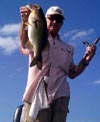 One place we have found some good bass is the N/S canals of the Farm (see photo). They are heavily grassed on the North end, but very open on the southern sections. Target the southern sections (hint, hint). Once you find a good fish, work the area well and you should find more. Also, watch for surface feeding. If you see a shiner go into high gear, you have probably found a school.
One place we have found some good bass is the N/S canals of the Farm (see photo). They are heavily grassed on the North end, but very open on the southern sections. Target the southern sections (hint, hint). Once you find a good fish, work the area well and you should find more. Also, watch for surface feeding. If you see a shiner go into high gear, you have probably found a school.
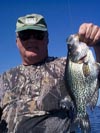 Crappie are really getting on the edge of the grass lines now, even back in the shallow areas. 3-4 feet of water will hold them. Forget that big E/W canal between the farm and the Marsh. All those boats you see in there are there because they caught fish in that canal real good 4-5 years ago. Now, the average crappie in the canal is 6-8 inches long and there are not many of them. I believe there are crappie in the canal, but no one catches them. The big ones are related to the grass (see photo). And, right now, they are moving to the edges well. Trust me on this one!!
Crappie are really getting on the edge of the grass lines now, even back in the shallow areas. 3-4 feet of water will hold them. Forget that big E/W canal between the farm and the Marsh. All those boats you see in there are there because they caught fish in that canal real good 4-5 years ago. Now, the average crappie in the canal is 6-8 inches long and there are not many of them. I believe there are crappie in the canal, but no one catches them. The big ones are related to the grass (see photo). And, right now, they are moving to the edges well. Trust me on this one!!
November 6, 2001
Water level 2-3 inches above normal and rising. Some gates are running off and on, but no water is being released from the Marsh. So, expect higher than normal levels for a few days and the potential for 'big brown ones' floating off the banks and into your boat lane. The hurricane did no damage, except provide excellent fishing during its windy conditions. (Love that wind! It makes bass do predictable things.)
We contacted the St. Johns water management District about the awful condition of the access road and it was graded yesterday. The grading did little to help the washboard effects and the holes, so we are rating it on a 6 out of 10. The District also said they were about to re-treat the road again with the TerraBond material. That is good for keeping dust down. But, so far, it has not held the road together. Still, we are hoping for better road days to come.
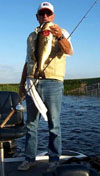 The water is clear and clean. With the rise in water, some surface grass mats are being covered. Coupled with cooling temperatures, this is causing some of the grass to recede well, opening more areas to fishing. Sunny Wells and I tested conditions yesterday for 3 hours (see photos) and found bass on structure associated with canal channel drops (C-rig worm), bass and crappie ganged up on moving water (crank plugs/jigs), and crappie attempting to move to the edges of grass beds (jigs).
The water is clear and clean. With the rise in water, some surface grass mats are being covered. Coupled with cooling temperatures, this is causing some of the grass to recede well, opening more areas to fishing. Sunny Wells and I tested conditions yesterday for 3 hours (see photos) and found bass on structure associated with canal channel drops (C-rig worm), bass and crappie ganged up on moving water (crank plugs/jigs), and crappie attempting to move to the edges of grass beds (jigs).
The bass seems exceptionally aggressive, possibly due to the excellent conditions at present. We found 2 nice schools, one of which was so active it was possible to catch 2 fish at once on the same plug.
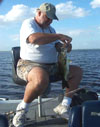 As a forecast, expect the bass to continue very good, with a few giant fish coming aboard. The ratio of giants will increase by January and continue through April. Crappie will gradually be found more and more on the edges of grass lines. You'll have to look a bit. But, when you find them, expect it to be a big school.
As a forecast, expect the bass to continue very good, with a few giant fish coming aboard. The ratio of giants will increase by January and continue through April. Crappie will gradually be found more and more on the edges of grass lines. You'll have to look a bit. But, when you find them, expect it to be a big school.
Bass will spawn in December through February, with crappie bedding around the middle of February. The crappie will be easily caught all the way into May. Giant Bluegill fishing gets right in the March through May timeframe. All during these periods, the great Florida 'winter' will provide cool, comfortable days and excellent outdoor experiences.
November 3, 2001
Water levels continue to be normal. Even with a good bit of rain, the St Johns Water Management folks are letting it out of the Stick Marsh about as fast as it comes in. Gates are running off and on. Possibly, the hurricane (Michelle) will dump a lot of rain and the gates will be open continually for awhile. The road is terrible!! After all those tax dollars spent, we find we have been had.
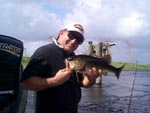 The grass is thinning in places. If the water levels are allowed to rise above normal pool, we may see more of it pass away. That will really open up the fishing areas and a LOT of good big fish will be taken. They are all still there. But, they are fat, dumb, happy, and well fed down beneath all that dark, cool grass with their food supply.
The grass is thinning in places. If the water levels are allowed to rise above normal pool, we may see more of it pass away. That will really open up the fishing areas and a LOT of good big fish will be taken. They are all still there. But, they are fat, dumb, happy, and well fed down beneath all that dark, cool grass with their food supply.
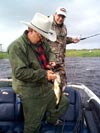 Had George Miller and his old college roommate, Frank Stagliano out on the 2nd of Nov. Winds were really tough. Not much place to fish except the basin at the SE floodgate in the Farm. The gate was running super strong and with LOTS of grass. Very, very difficult to fish it well until afternoon, when it cleared up a bit. No monsters, but we caught fish there. Over to the west side of the Farm at noon and took the Swimming Worm for an excursion. Lots of little fish, but not much for size. The wind was tough there, but the grass knocked the waves down well.
Had George Miller and his old college roommate, Frank Stagliano out on the 2nd of Nov. Winds were really tough. Not much place to fish except the basin at the SE floodgate in the Farm. The gate was running super strong and with LOTS of grass. Very, very difficult to fish it well until afternoon, when it cleared up a bit. No monsters, but we caught fish there. Over to the west side of the Farm at noon and took the Swimming Worm for an excursion. Lots of little fish, but not much for size. The wind was tough there, but the grass knocked the waves down well.
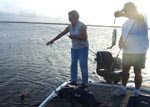 Sunny Wells, my wife Dot, and I went over to neighboring Blue Cypress Lake for a fish fry yesterday. As usual, Joe and Jeannie Middleton did things up right. Even had a little alligator fried nice and brown. It was a 'contribution' affair to raise money to add more fish to the stocking program for the lake. On the way back, we dropped in on the Stick Marsh for a couple of hours and located a good school on structure. I played guide (as usual) and Dot and Sunny fished. The photos are poor, but I was shooting into the sun and just could not move the anchored boat.
Sunny Wells, my wife Dot, and I went over to neighboring Blue Cypress Lake for a fish fry yesterday. As usual, Joe and Jeannie Middleton did things up right. Even had a little alligator fried nice and brown. It was a 'contribution' affair to raise money to add more fish to the stocking program for the lake. On the way back, we dropped in on the Stick Marsh for a couple of hours and located a good school on structure. I played guide (as usual) and Dot and Sunny fished. The photos are poor, but I was shooting into the sun and just could not move the anchored boat.

Today's Weather for
the Stick Marsh Area
Past Fishing Reports
Farm 13/Stick Marsh Information Guide
Email questions to jporter@jimporter.org.
|
Recommended sites by The Fishin' Tipster |
A common question that we get: "Is there somewhere close to get bait and tackle?" This is where we get our bait.

Pete and Tina Heinz / 9 South Mulberry St. / Fellsmere, FL 32948 / 772-571-9855
Get your site listed here
Let us help you drive more targeted traffic to your site.
|


Rank our Site
©Copyright 2001-07 All rights reserved by Jim Porter, any reproduction, quotation or other use of this site or its elements is prohibited without the express written permission of Jim Porter
|
|


 FROGG TOGGS RAIN GEAR
FROGG TOGGS RAIN GEAR
THE BEST PRICES AVAILABLE!!


|
|







